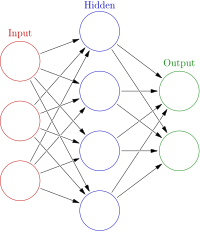
Photo from wikipedia
ABSTRACT The aim of this work is to generate synthetic computed tomography (sCT) images from multi-sequence magnetic resonance (MR) images using an adversarial network and to assess the feasibility of… Click to show full abstract
ABSTRACT The aim of this work is to generate synthetic computed tomography (sCT) images from multi-sequence magnetic resonance (MR) images using an adversarial network and to assess the feasibility of sCT-based treatment planning for brain radiotherapy. Datasets for 15 patients with glioblastoma were selected and 580 pairs of CT and MR images were used. T1-weighted, T2-weighted and fluid-attenuated inversion recovery MR sequences were combined to create a three-channel image as input data. A conditional generative adversarial network (cGAN) was trained using image patches. The image quality was evaluated using voxel-wise mean absolute errors (MAEs) of the CT number. For the dosimetric evaluation, 3D conformal radiotherapy (3D-CRT) and volumetric modulated arc therapy (VMAT) plans were generated using the original CT set and recalculated using the sCT images. The isocenter dose and dose–volume parameters were compared for 3D-CRT and VMAT plans, respectively. The equivalent path length was also compared. The mean MAEs for the whole body, soft tissue and bone region were 108.1 ± 24.0, 38.9 ± 10.7 and 366.2 ± 62.0 hounsfield unit, respectively. The dosimetric evaluation revealed no significant difference in the isocenter dose for 3D-CRT plans. The differences in the dose received by 2% of the volume (D2%), D50% and D98% relative to the prescribed dose were <1.0%. The overall equivalent path length was shorter than that for real CT by 0.6 ± 1.9 mm. A treatment planning study using generated sCT detected only small, clinically negligible differences. These findings demonstrated the feasibility of generating sCT images for MR-only radiotherapy from multi-sequence MR images using cGAN.
Journal Title: Journal of Radiation Research
Year Published: 2019
Link to full text (if available)
Share on Social Media: Sign Up to like & get
recommendations!